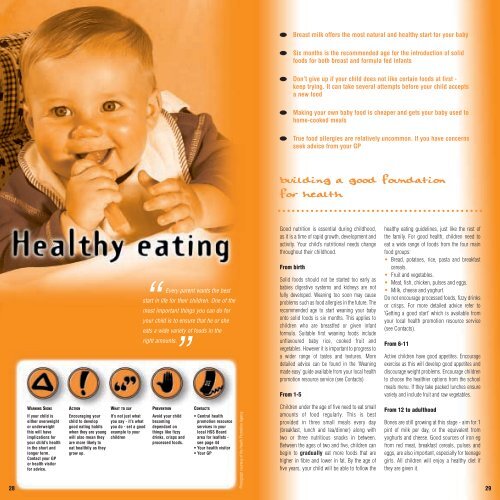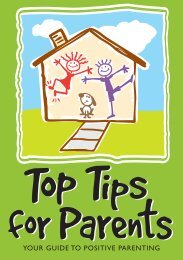Safe Parenting Handbook (PDF 1.07 Mb) - Department of Health ...
Safe Parenting Handbook (PDF 1.07 Mb) - Department of Health ...
Safe Parenting Handbook (PDF 1.07 Mb) - Department of Health ...
- No tags were found...
Create successful ePaper yourself
Turn your PDF publications into a flip-book with our unique Google optimized e-Paper software.
Breast milk <strong>of</strong>fers the most natural and healthy start for your babySix months is the recommended age for the introduction <strong>of</strong> solidfoods for both breast and formula fed infantsDon’t give up if your child does not like certain foods at first -keep trying. It can take several attempts before your child acceptsa new foodMaking your own baby food is cheaper and gets your baby used tohome-cooked mealsTrue food allergies are relatively uncommon. If you have concernsseek advice from your GPbuilding a good foundationfor health“Every parent wants the beststart in life for their children. One <strong>of</strong> themost important things you can do foryour child is to ensure that he or sheeats a wide variety <strong>of</strong> foods in the”right amounts.Good nutrition is essential during childhood,as it is a time <strong>of</strong> rapid growth, development andactivity. Your child’s nutritional needs changethroughout their childhood.From birthSolid foods should not be started too early asbabies digestive systems and kidneys are notfully developed. Weaning too soon may causeproblems such as food allergies in the future. Therecommended age to start weaning your babyonto solid foods is six months. This applies tochildren who are breastfed or given infantformula. Suitable first weaning foods includeunflavoured baby rice, cooked fruit andFrom 6-11vegetables. However it is important to progress toa wider range <strong>of</strong> tastes and textures. Moredetailed advice can be found in the ‘Weaningmade easy’ guide available from your local healthpromotion resource service (see Contacts)From 1-5healthy eating guidelines, just like the rest <strong>of</strong>the family. For good health, children need toeat a wide range <strong>of</strong> foods from the four mainfood groups:• Bread, potatoes, rice, pasta and breakfastcereals.• Fruit and vegetables.• Meat, fish, chicken, pulses and eggs.• Milk, cheese and yoghurt.Do not encourage processed foods, fizzy drinksor crisps. For more detailed advice refer to‘Getting a good start’ which is available fromyour local health promotion resource service(see Contacts).Active children have good appetites. Encourageexercise as this will develop good appetites anddiscourage weight problems. Encourage childrento choose the healthier options from the schoolmeals menu. If they take packed lunches ensurevariety and include fruit and raw vegetables.28WARNING SIGNSIf your child iseither overweightor underweightthis will haveimplications foryour child’s healthin the short andlonger term.Contact your GPor health visitorfor advice.ACTIONWHAT TO SAYEncouraging your It’s not just whatchild to develop you say - it’s whatgood eating habits you do - set a goodwhen they are young example to yourwill also mean they childrenare more likely toeat healthily as theygrow up.PREVENTIONAvoid your childbecomingdependant onthings like fizzydrinks, crisps andprocessed foods.CONTACTS• Central healthpromotion resourceservices in yourlocal HSS Boardarea for leaflets -see page 44• Your health visitor• Your GPPhotograph courtesy <strong>of</strong> the <strong>Health</strong> Promotion AgencyChildren under the age <strong>of</strong> five need to eat smallamounts <strong>of</strong> food regularly. This is bestprovided in three small meals every day(breakfast, lunch and tea/dinner) along withtwo or three nutritious snacks in between.Between the ages <strong>of</strong> two and five, children canbegin to gradually eat more foods that arehigher in fibre and lower in fat. By the age <strong>of</strong>five years, your child will be able to follow theFrom 12 to adulthoodBones are still growing at this stage - aim for 1pint <strong>of</strong> milk per day, or the equivalent fromyoghurts and cheese. Good sources <strong>of</strong> iron egfrom red meat, breakfast cereals, pulses andeggs, are also important, especially for teenagegirls. All children will enjoy a healthy diet ifthey are given it.29






